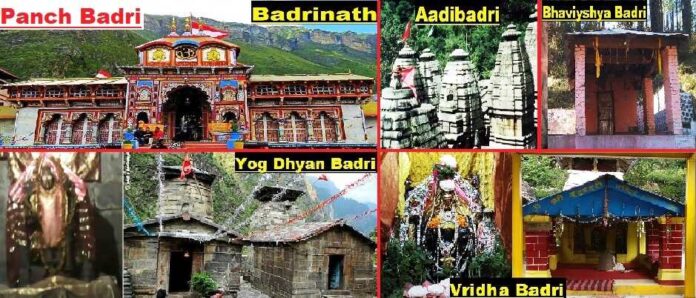Panch Badri is a term used to call five famous temples collectively, located in the Chamoli district of Uttarakhand. All 5 temples of Panch-Badri are dedicated to Lord Vishnu. In this article, we have shared all the important details like the Panchbadri temple’s name, the history of Panch Badri, the Panch Badri yatra route map, and the distance guide.
History of Panch Badri Yatra
According to the Puranas, Brahma’s son Dharma and his wife Murti Devi had traveled to Badrinath in ancient times. Nara and Narayan were the sons of both of them.
Nar and Narayan, both of which are modern names of Himalayan mountains. They chose the place to spread their religion and each of them wed the spacious valleys in the Himalayas.
Searching for an ideal place to set up a hermitage, they came across the five Badris of the Panch Badri, namely Vridha Badri, Yog Bhadri, Dhyan Badri, Bhavish Badri, and Badrinath (Badrikashram).
History of Char Dham Temples
Five Panch Badri Temples Image

5 Panch Badri Temples Names
Here is the right order of sequence to visit temples of Panch Badri Yatra.
- Adi Badri Temple
- Badrinath Temple
- Bhaviyshya Badri Temple
- Vridha Badri Temple
- Yog Dhyan Badri Temple
How To Reach Panch Badri Temples?
- It takes many days to visit all five shrines of Lord Vishnu.
- There is a spherical trek which is the only way to visit all Panch Badri temples.
- And for most of the part, you have to walk from temple to temple.
Char Dham Distance from Delhi
- Delhi to Kedarnath (466 km)
- Delhi to Badrinath (555 km)
- Delhi to Gangotri (530 km)
- Delhi to Yamunotri (485 km)
1. Adi Badri Temple: First Panch Badri
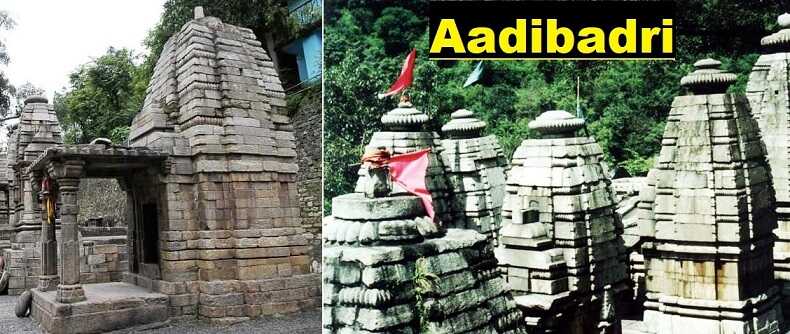
Known as the first pilgrimage of Badrikashram and worshiped Shri Adi Badri Dham is recognized as the first pilgrimage.
Adi Badri is situated at an altitude of 1,630 meters above sea level. Adi Badri is part of the famous Panch Badri of Uttarakhand.
It is a group of sixteen temples, belonging to the Gupta period. Among them is the Narayan temple, where a black stone idol of Vishnu, three feet high is enshrined.
This place is within the Badrikshetra, and Badrinath being the name for Vishnu, the temple is known as the Adi Badri.
Adi Badri Rout:
- There are 2 routes to reach Adi Badri.
- One route reaches Adibadri via Nainital, Ranikhet, Dwarahat, Chaukhutia, Gairsain.
- The second route reaches Adi Badri from Haridwar via Rishikesh, Devprayag, Srinagar, Rudraprayag, and Karnprayag. This distance from Haridwar is 213 Kilometers.
Adi Badri Route Location:
Adi Badri from Karnprayag is situated at a distance of 19 km from the Chaukhutia-Ranikhet motorway.
Travel Tips for Aadi Badri:
-
The doors of the Adi Badri temple remain open for 11 months a year. This is worship for 11 months. The doors of Adi Badri remain closed for 1 month in winter from the 15th of December to the 14th of January. Its doors open on January 14, the day of Makar Sankranti. So if you are planning to visit the temple during winter. Then don’t forget to check the opening and closing dates.
-
Every day the worship is done at 5 in the morning, the rice bhog at 12 pm, and the aarti is completed between 7 and 8 at night.
- Photography is not allowed inside the temple due to religious reasons. It would be wise to follow the rules set up by temple authorities.
- While traveling in the monsoon, check with local authorities and tour guides about the weather conditions before you start the journey.
2. Badrinath Temple: Second Panch Badri
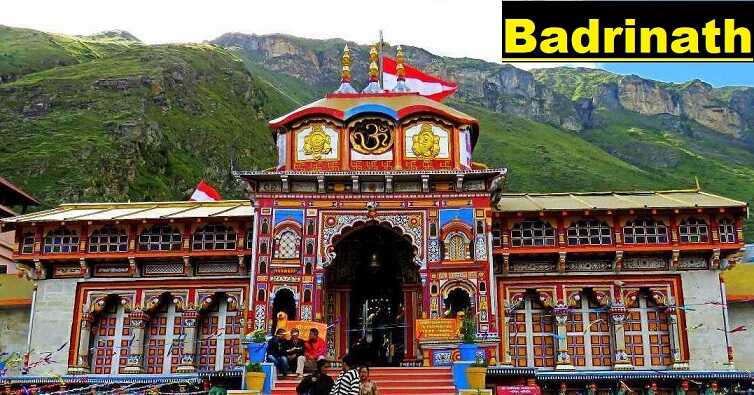
Badrinath or Badrinarayana Temple is a Hindu Temple dedicated to Lord Vishnu.
It is located in Garhwal hill tracts along the banks of the Maa Alaknanda River in Chamoli District in Uttarakhand, India.
The hill tracts are located 3,133 m (10,279 ft) above sea level. The Nar Parvat (Nar Hill) is located opposite the temple, while the Narayana Parvat (Narayan Hill) is located behind the Neelkanth peak.
Badrinath is one of these four pilgrimage sites which is situated in the northern direction of India. Badrinath Temple is the only temple that is part of both the Char Dhams of India and the Chota Char Dhams of Uttarakhand.
Travel Tips For Badrinath
- While traveling in the monsoon, check with local authorities and tour guides about the weather conditions before you start the journey.
- Photography is not allowed inside the temple due to religious reasons. It would be wise to follow the rules set up by temple authorities.
- When you plan to visit Badrinath, always bring warm clothes with you. It doesn’t depend on which month you are going to visit Badrinath.
Joshimath is the main city before Badrinath temple. It has a colorful temple and monastery, which has many small cells for meditation. And pooja for Badrinath is done in Joshimath only when snow in the hills rises cold in winter.
The doors of Badrinath Dham are closed for 6 months in the winter season.
For this period, Lord Vishnu’s worship is done in Joshimath with all the rituals. Joshimath has all the different forms of Lord Vishnu.
So if you are not able to visit Panch Badri, then getting a darshan of all deities at Joshimath is equal to being blessed by all the forms of Lord Vishnu.
Must Read Amazing Facts:
3. Bhavisya Badri Temple: Third Panch Badri
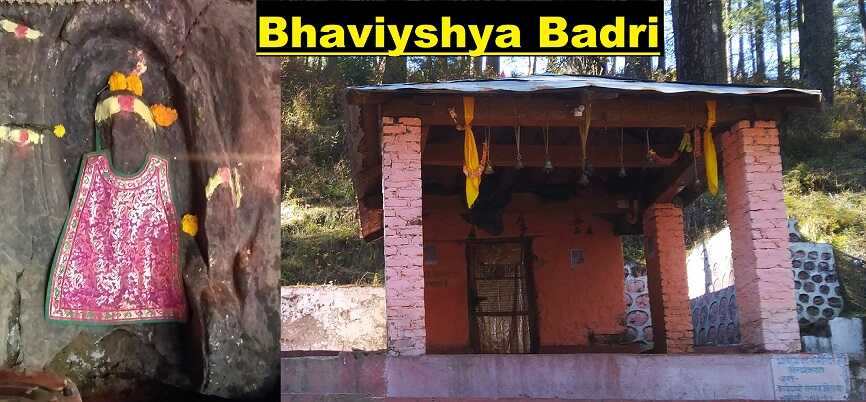
Bhavishya Badri is one of the Panch Badri Temples located at a height of 2744 meters near Joshimath. Beyond the Tapovan, Bhavishya Badri is situated 17 km from Joshimath in Subhain Village.
The Bhavishya Badri is one of the “Sapt Badri” temples in the Badrikshetra.
This small temple deity is Lord Vishnu and is known to be the future seat of Badrinath. There is a beautiful water spring in Bhavishya Badri and the place has many Cedar trees.
Bhavishya Badri Rout:
- One route from Joshimath on Badrinath Road leads to Shri Badrinath via Vishnu Prayag.
- Another route from Joshimath goes towards Niti Valley via Tapovan, Saldhar, and Malaria.
- At a distance of 18 km from Joshimath on this route a place named Saldhar.
- After crossing Saldhar, a tough climb of 4 kilometers you reach Subhai Village. Shri Bhavishya Badri is located in Subhai Village.
Bhavishya Badri Location
Bhavishya Badri is situated at an altitude of 2 km from Subhai village. Subhani Village, located in Joshimath, Chamoli, Uttarakhand.
Bhavishya Badri is situated at an altitude of 2744 meters above sea level.
Travel Tips for Bhavishya Badri:
- Always carry warm clothes when you travel to Uttarakhand Hilly areas.
- While traveling in the monsoon, check with local authorities and tour guides about the weather conditions before you start the journey.
- Photography is not allowed inside the temple due to religious reasons. It would be wise to follow the rules set up by temple authorities.
4. Vridha Badri Temple: Fourth Panch Badri
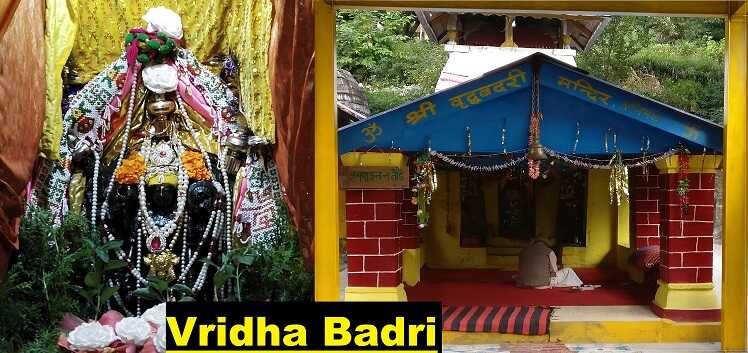
Virdha Badri is located at Animath in the Chamoli District of Uttarakhand. The Vridha Badri temple dates back to the times when India was ruled by the Gupta Dynasty.
The Vridha Badri is one of the “Sapt Badri” temples in the Badrikshetra.
The Vridha Badri holds a very high significance in Hindu mythology. The name of Vridha Badri is derived from the form of an old man whom Lord Vishnu is worshiped here. It is situated ahead of the Kalpeshar Mahadev Temple, ahead of Helang.
The elevation of Vridha Badri is 1,380m in Animath, Chamoli.
Vridh Badri Rout:
Joshimath is reached from Chamoli via Pipalkoti, Helang, and Animath. Vridha Badri Mandir is located in Nimath village, 7 kilometers before Joshimath.
Vridh Badri Location:
Vridha Badri Mandir is located in Animath village, 7 kilometers before Joshimath.
Travel Tips for Vridha Badri:
- This temple remains open for 12 months a year. so u can visit any time in the whole year.
- Always carry warm clothes when you travel to Uttarakhand Hilly areas.
- While traveling in the monsoon, check with local authorities and tour guides about the weather conditions before you start the journey.
5. Yog Dhyan Badri Temple: Fifth Panch Badri
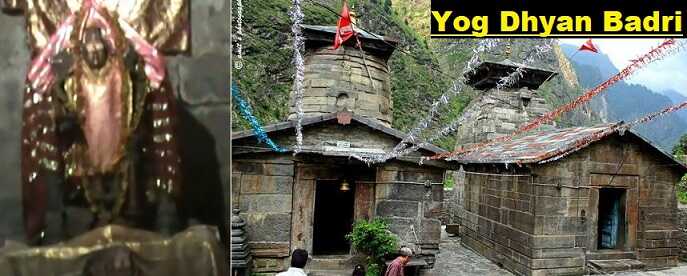
Yogadhyan Badri, also known as the Yoga Badri, is situated at a distance of 23 km from Badrinath and is located at Pandukeshwar near Govind Ghat. It is an ancient temple and is a home for Lord Vishnu.
It is believed that the father of Pandavas, King Pandu meditated at this site so that Lord Vishnu could cleanse him of his sin of killing two mating deer.
The Pandavas were born in the same place and Pandu also died at this site. It is also believed that Pandu had installed an idol of Lord Vishnu in Yogadhyan Badri.
This idol of Lord Vishnu is in a meditative posture and therefore it is also called Yogadhyan Badri. Moreover, the idol is carved from Shaligram stone which imparts a beautiful look.
Yog Dhyan Badri is also considered the winter abode for the Utsava-murti (festival-image) of Badrinath when the temple of Badrinath is closed. Hence, it is religiously ordained that a pilgrimage will not be complete without offering prayers at this place.
Bhatts (priests) from South India serve as chief priests in the temple.
Yog Dhyan Badri Route:
Situated at a distance of 18 kilometers from Joshimath and 23 kilometers from Badrinath Pandukeshwar can be reached by Jeep or taxi from Joshimath.
Yog Dhyan Badri Location:
Yoga Dhyan Badri is located at a distance of 3 Kilometers from Govind Ghat at a 100-meter walking distance from Badrinath Road.
Travel Tips for Yog Dhyan Badri:
- Always carry warm clothes when you travel to Uttarakhand Hilly areas.
- While traveling in the monsoon, check with local authorities and tour guides about the weather conditions before you start the journey.
- Photography is not allowed inside the temple due to religious reasons. It would be wise to follow the rules set up by temple authorities.
Explore Badrinath
Sapt Badri (7 temples of Lord Badri Vishal)
Apart from Panch Badri Yatra, There are a few more temples of Lord Vishnu that have been called Badri by their name.
Dhyan Badri and Ardha Badri, by adding these two temples to Panch Badri temple, local people collectively know all of them as Sapt Badri.
Sapt Badri Temple names are as follows;
1. Badrinath
2. Adi Badri
3. Vriddha Badri
4. Bhavishya Badri
5. Yogadhyan Badri
6. Dhyan Badri
7. Ardha Badri
One more famous temple of Lord Vishnu is Narasingh Badri (Narasimha Temple).
Though it is not part of Panch Badri and Sapt Badri. But it is considered one of the important temples in the region and is called by the name of Badri temple.
Complete Travel Guide
- Kedarnath Yatra 2024 Guide
- Badrinath Yatra 2024 Guide
- Gangotri Yatra2024 Guide
- Yamunotri Yatra 2023 Guide
